JAPANESE TO BE MOVED FROM WEST COAST
Washington, D.C. · February 19, 1942
On this date in 1942 President Franklin D. Roosevelt signed Executive Order 9066. It authorized the War Department to designate “military areas” in the U.S. and exclude from them anyone whom the department felt to be a danger to the security of the nation. Although the order was carefully neutral, it ultimately led to the internment of more than 110,000 persons of Japanese ancestry, citizens and non-citizens alike, living along the West Coast of the U.S. Almost three-quarters of those interned were American-born U.S. citizens, reclassified by the government as “non-aliens” to minimize any awkwardness. (In Canada, 20,000 Japanese Canadians and Japanese suffered similar treatment. South of the border almost 5,000 Japanese were removed from Mexico’s Pacific Coast.) Deprived of their property, Japanese American and Japanese-born internees were taken first to assembly centers, or temporary detention camps (the Santa Anita, California racetrack stables was one), then to one of ten permanent inland relocation centers where they were forced to live behind barbed wire, watched over by armed guards (see map below). German Americans and German U.S. residents escaped a similar fate and were not interned en masse. Under the U.S. Justice Department’s Enemy Alien Control Program, the government detained and interned over 11,000 German enemy aliens, as well as a small number of German American citizens, either naturalized or native born. The population of German citizens in the United States—not to mention American citizens of German birth—was far too large for a general policy of internment comparable to that used in the case of the Japanese. Instead, German citizens were detained and removed from coastal areas on an individual basis. The evictions amounted to only several hundred. In addition, over 4,500 ethnic Germans were brought to the U.S. from Latin America and similarly detained based on a list drawn up by the Federal Bureau of Investigation. The FBI suspected these Germans of subversive activities abroad and, following Germany’s declaration of war on the U.S., demanded their eviction to this country for detention or their return to Germany. Many had been residents of Latin America for years, some for decades. Nine Latin American countries and Canada set up their own Axis internment camps.
[amazon_carousel widget_type=”ASINList” width=”600″ height=”200″ title=”Recommended Reading” market_place=”US” shuffle_products=”False” show_border=”False” asin=”0809078961,0231129238,0295982993,1477513981,067401118X,0803228066,0595393330,1599557967,1890771309,0939165538″ /]
Executive Order 9066 Cleared the Way for the Forced Relocation of West Coast Japanese Americans to Internment Camps Far From Their Homes
 |
Above: Map of World War II internment camps for Japanese Americans as well as for over 31,000 suspected enemy aliens and their families interned under the Enemy Alien Control Program. (The latter camps and military facilities are indicated by stars; for example, Kooskia Internment Camp in Idaho and Fort Missoula Internment Camp in Montana.) In the map legend, WCCA = Wartime Civil Control Administration, WRA = War Relocation Authority. More than 110,000 Japanese Americans and resident Japanese aliens would eventually be removed from their homes in California, the western halves of Oregon and Washington, and southern Arizona as part of the single-largest forced relocation in U.S. history. In Hawaii, where 150,000-plus Japanese Americans comprised over one-third of the population, only 1,200 to 1,800 were interned.
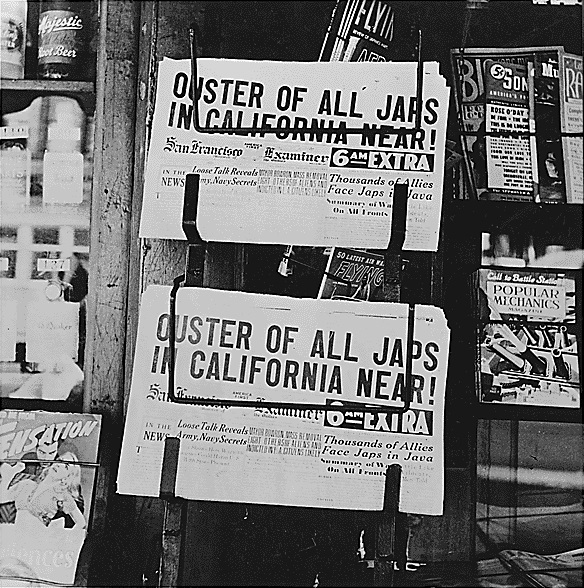 | 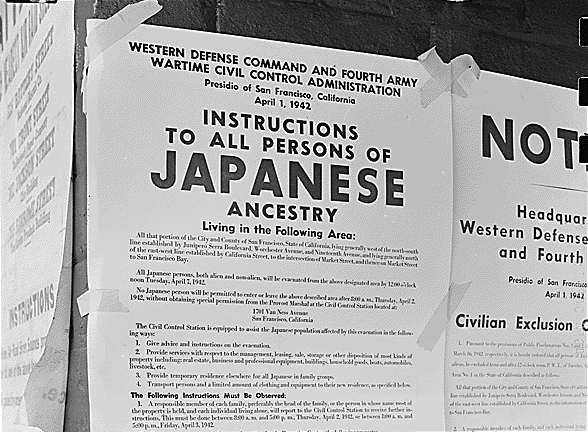 |
Left: “OUSTER OF ALL JAPS IN CALIFORNIA NEAR!” San Francisco Examiner headlines of Japanese relocation, February 27, 1942.
![]()
Right: Official notice of exclusion and removal, April 1, 1942. The posted exclusion order directed Japanese Americans living in the first San Francisco section to evacuate. Years before the December 7, 1941, Japanese bombing of Pearl Harbor, Hawaii, the U.S. government had drafted plans to intern some Japanese Americans and had already placed some West Coast communities under surveillance.
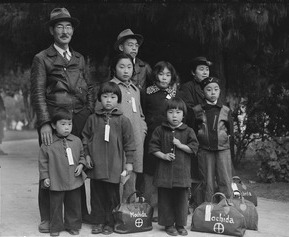 | 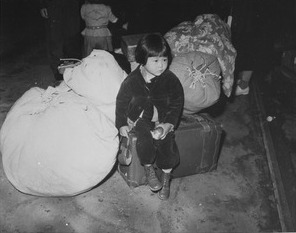 |
Left: Members of the Mochida family await an evacuation bus, Alameda County, California, May 8, 1942.
![]()
Right: A young evacuee of Japanese ancestry waits with the family baggage before leaving by bus for an assembly center in the spring of 1942.
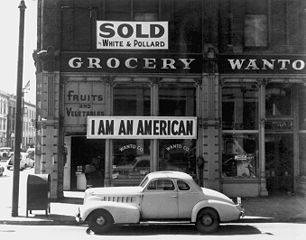 | 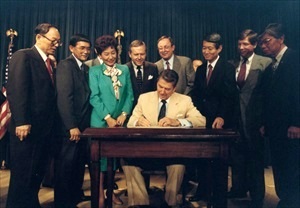 |
Left: Owned by a University of California graduate, this Oakland, California store closed in March 1942 following orders to persons of Japanese descent to evacuate from certain West Coast areas.
![]()
Right: In 1944 the U.S. Supreme Court upheld the constitutionality of the exclusion orders, described by many Americans as the worst official civil rights violation of modern U. S. history. On August 10, 1988, President Ronald Reagan signed the Civil Liberties Act of 1988, which granted reparations for the wartime internment of Japanese Americans.
Disingenuous Government-Produced Film From 1943 Defends the Massive Internment of Japanese Americans During World War II
![]()

 History buffs, there is good news! The Daily Chronicles of World War II is now available as an ebook for $4.99 on Amazon.com. Containing a year’s worth of dated entries from this website, the ebook brings the story of this tumultuous era to life in a compelling, authoritative, and succinct manner. Featuring inventive navigation aids, the ebook enables readers to instantly move forward or backward by month and date to different dated entries. Simple and elegant! Click
History buffs, there is good news! The Daily Chronicles of World War II is now available as an ebook for $4.99 on Amazon.com. Containing a year’s worth of dated entries from this website, the ebook brings the story of this tumultuous era to life in a compelling, authoritative, and succinct manner. Featuring inventive navigation aids, the ebook enables readers to instantly move forward or backward by month and date to different dated entries. Simple and elegant! Click 











